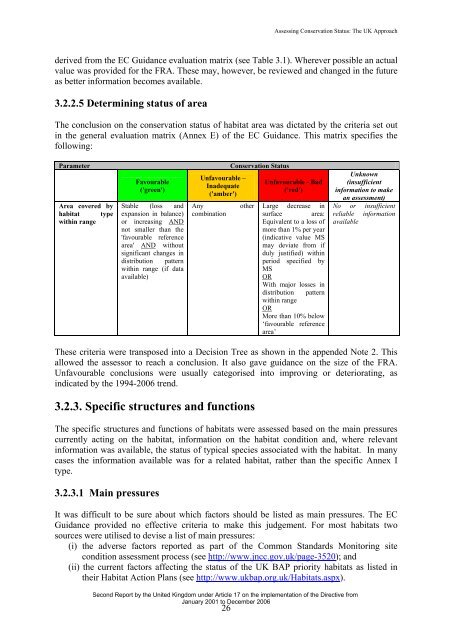Assessing Conservation Status: The UK Approach - JNCC
Assessing Conservation Status: The UK Approach - JNCC
Assessing Conservation Status: The UK Approach - JNCC
Create successful ePaper yourself
Turn your PDF publications into a flip-book with our unique Google optimized e-Paper software.
<strong>Assessing</strong> <strong>Conservation</strong> <strong>Status</strong>: <strong>The</strong> <strong>UK</strong> <strong>Approach</strong><br />
derived from the EC Guidance evaluation matrix (see Table 3.1). Wherever possible an actual<br />
value was provided for the FRA. <strong>The</strong>se may, however, be reviewed and changed in the future<br />
as better information becomes available.<br />
3.2.2.5 Determining status of area<br />
<strong>The</strong> conclusion on the conservation status of habitat area was dictated by the criteria set out<br />
in the general evaluation matrix (Annex E) of the EC Guidance. This matrix specifies the<br />
following:<br />
Parameter<br />
Area covered by<br />
habitat type<br />
within range<br />
Favourable<br />
('green')<br />
Stable (loss and<br />
expansion in balance)<br />
or increasing AND<br />
not smaller than the<br />
'favourable reference<br />
area' AND without<br />
significant changes in<br />
distribution pattern<br />
within range (if data<br />
available)<br />
Unfavourable –<br />
Inadequate<br />
('amber')<br />
Any<br />
combination<br />
<strong>Conservation</strong> <strong>Status</strong><br />
other<br />
Unfavourable - Bad<br />
('red')<br />
Large decrease in<br />
surface area:<br />
Equivalent to a loss of<br />
more than 1% per year<br />
(indicative value MS<br />
may deviate from if<br />
duly justified) within<br />
period specified by<br />
MS<br />
OR<br />
With major losses in<br />
distribution pattern<br />
within range<br />
OR<br />
More than 10% below<br />
‘favourable reference<br />
area’<br />
Unknown<br />
(insufficient<br />
information to make<br />
an assessment)<br />
No or insufficient<br />
reliable information<br />
available<br />
<strong>The</strong>se criteria were transposed into a Decision Tree as shown in the appended Note 2. This<br />
allowed the assessor to reach a conclusion. It also gave guidance on the size of the FRA.<br />
Unfavourable conclusions were usually categorised into improving or deteriorating, as<br />
indicated by the 1994-2006 trend.<br />
3.2.3. Specific structures and functions<br />
<strong>The</strong> specific structures and functions of habitats were assessed based on the main pressures<br />
currently acting on the habitat, information on the habitat condition and, where relevant<br />
information was available, the status of typical species associated with the habitat. In many<br />
cases the information available was for a related habitat, rather than the specific Annex I<br />
type.<br />
3.2.3.1 Main pressures<br />
It was difficult to be sure about which factors should be listed as main pressures. <strong>The</strong> EC<br />
Guidance provided no effective criteria to make this judgement. For most habitats two<br />
sources were utilised to devise a list of main pressures:<br />
(i) the adverse factors reported as part of the Common Standards Monitoring site<br />
condition assessment process (see http://www.jncc.gov.uk/page-3520); and<br />
(ii) the current factors affecting the status of the <strong>UK</strong> BAP priority habitats as listed in<br />
their Habitat Action Plans (see http://www.ukbap.org.uk/Habitats.aspx).<br />
Second Report by the United Kingdom under Article 17 on the implementation of the Directive from<br />
January 2001 to December 2006<br />
26
















